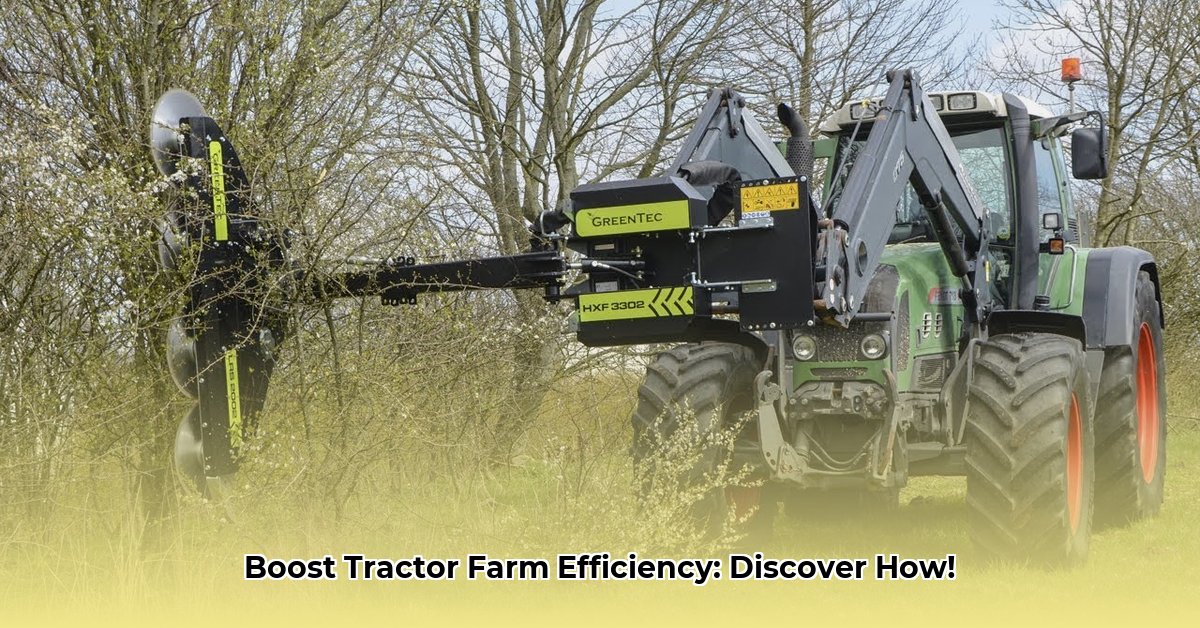
Limb Saws: A Revolution in Brush Management
Tired of backbreaking brush clearing and time-consuming limb trimming? Tractor-mounted limb saws offer a powerful, efficient, and safer solution for landowners and farmers. This guide explores the functionality, benefits, and limitations of limb saws, providing a step-by-step approach to safe and effective operation, and a cost-benefit analysis to help you decide if this technology is right for you. For more information on specific models, check out this helpful resource: Learn More.
How Limb Saws Work
Limb saws are essentially powerful, hydraulically powered saws mounted on a long, articulated arm attached to your tractor. The hydraulic system provides the power to spin a sharp saw blade, allowing you to trim branches from the safety and comfort of your tractor cab. The extended reach of the arm allows for efficient pruning of branches high above ground level and in difficult-to-reach spots. This precision control is particularly beneficial for trimming near orchards or in confined spaces. Think of it as having a robotic arm controlled from your tractor seat, accurately cutting branches with minimal effort.
Advantages of Using Limb Saws
The benefits of limb saws are significant, impacting both efficiency and safety. One farmer, John Miller, owner of Miller Farms in Iowa, reported, "I cut more tree limbs in one hour than I've probably cut by hand in the past ten years!" This significant increase in efficiency translates directly into substantial labor cost savings, freeing up valuable time for other farm tasks. But efficiency isn't the only advantage; safety is drastically improved. Operating from the secure environment of a tractor cab dramatically reduces the risk of falls from ladders or injuries from handling heavy equipment. A safer working environment not only translates to fewer workplace accidents, but also protects your most valuable asset – yourself.
Limitations and Considerations
While limb saws significantly boost efficiency and safety, understanding their limitations is crucial for informed decision-making. The reach of the saw is limited by the length of its arm; while some models reach up to 21 feet vertically, this may still fall short for some tasks. Additionally, there's a maximum cutting diameter that generally ranges between 2 and 4.5 inches depending on the model. Larger branches will require alternative methods.
Operator skill is paramount. Safe operation requires proper training and familiarity with the machine. Another key consideration is tractor compatibility – sufficient hydraulic power is essential. A flow rate of 15 GPM (gallons per minute) is often cited as a minimum requirement. Operating a limb saw with insufficient hydraulic power can lead to poor performance, damaging the equipment, or even causing accidents. Always carefully review the specific hydraulic requirements stated in the limb saw's manual before purchase.
Cost-Benefit Analysis: Is it Worth the Investment?
The initial cost of a limb saw system is substantial. However, the potential long-term cost savings can quickly outweigh this initial expense. Consider the labor costs associated with manual clearing, the potential costs of injuries, and the time diverted from other essential farm tasks. A careful financial projection comparing manual labor costs to limbsaw operation, factoring in maintenance and potential repairs, will assist in determining the return on investment (ROI). This projection should also take into account the potential for reduced insurance premiums due to decreased workplace accidents risk. Many farmers find that the increased efficiency and reduced labor costs result in a strong ROI within several years. The exact ROI will vary depending on factors like property size, tree density, and frequency of clearing needed.
Step-by-Step Guide to Safe Operation
Safe operation is paramount. Before starting, always follow these crucial steps:
- Pre-Operation Inspection: Check the limb saw (and your tractor's hydraulic lines) for any damage or wear; ensure all bolts and connections are secure.
- Hydraulic System Check: Verify your tractor's hydraulic system is functioning correctly and has sufficient flow rate (minimum 15 GPM). Check the hydraulic fluid level.
- Positioning and Setup: Plan your work area carefully, avoiding obstructions and ensuring adequate visibility. Stay clear of power lines.
- Controlled Cutting: Make slow, deliberate cuts to prevent blade kickback. Never force the saw. If the blade binds, stop immediately and reposition before continuing.
- Post-Operation Check: After each use, perform a post-operation inspection. Check for damage and clean the equipment.
Conclusion: Making the Right Choice for Your Farm
Tractor-mounted limb saws represent a significant advance in farm management technology. By carefully weighing the advantages, limitations, and costs, and by following safe operating procedures, you can determine if this technology offers a practical solution for boosting your farm's efficiency and safety. Remember, a thorough cost-benefit analysis coupled with prioritizing safety is key to making an informed decision that benefits both your bottom line and your well-being.